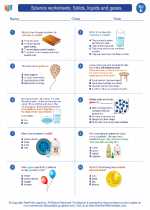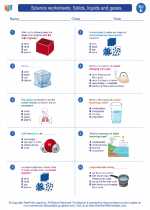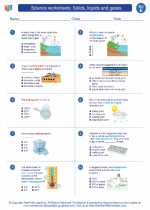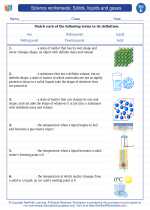Solids, Liquids, and Gases
In science, we learn about the three states of matter: solids, liquids, and gases. Each state has unique properties and characteristics.
Solids
Solids have a definite shape and volume. The particles in a solid are tightly packed together and do not move around much. They vibrate in place, but do not move from one location to another. Examples of solids include wood, metal, and ice.
Liquids
Liquids have a definite volume but take the shape of their container. The particles in a liquid are close together, but they can move past each other. This allows liquids to flow and take the shape of the container they are in. Examples of liquids include water, milk, and oil.
Gases
Gases have neither a definite shape nor a definite volume. They take the shape and volume of their container. The particles in a gas are far apart and move freely. They spread out to fill the space they are in. Examples of gases include air, helium, and carbon dioxide.
Study Guide
Now that we've learned about the three states of matter, let's review with some questions:
- What are the three states of matter?
- How are the particles arranged in a solid?
- What is the defining characteristic of a liquid?
- Give an example of a gas.
- What happens to the shape and volume of a gas?
◂Science Worksheets and Study Guides Fifth Grade. Science worksheets: Solids, liquids and gases.

 Worksheet/Answer key
Worksheet/Answer key
 Worksheet/Answer key
Worksheet/Answer key
 Worksheet/Answer key
Worksheet/Answer key
 Vocabulary/Answer key
Vocabulary/Answer key
